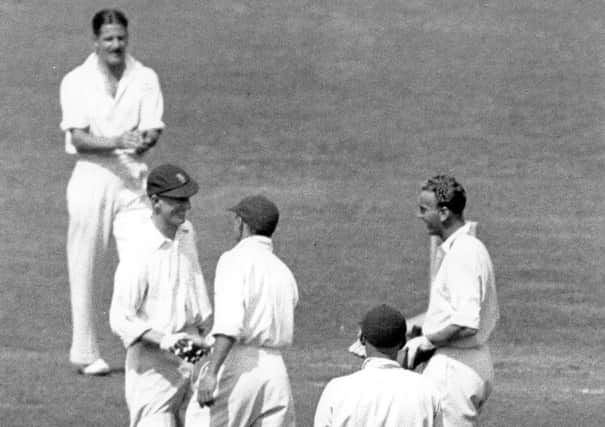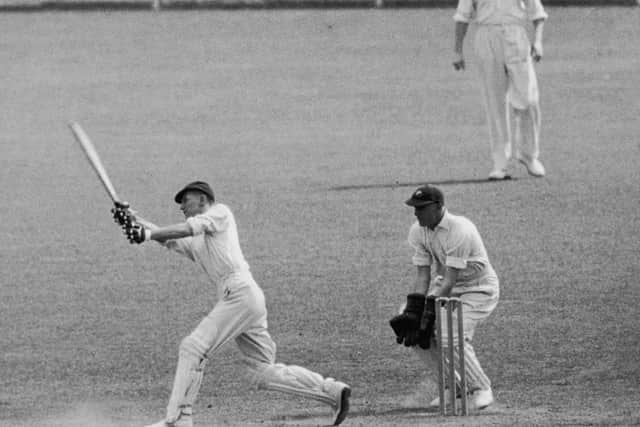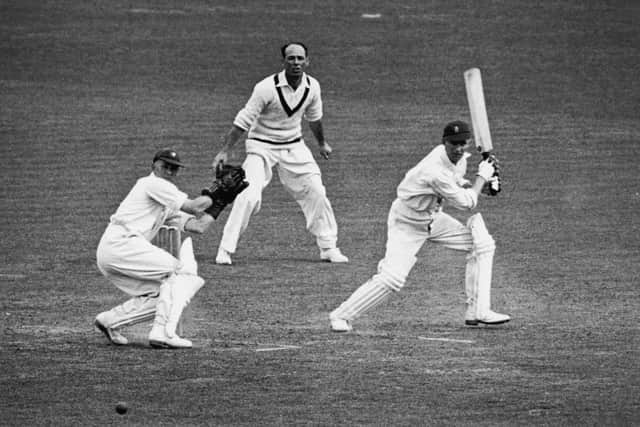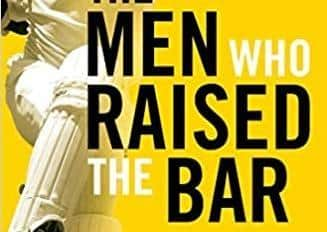When Len Hutton eclipsed Don Bradman with record knock at The Oval


The Men Who Raised the Bar, published by Wisden, looks at how the record has evolved from the inaugural Test match in 1877, when Charles Bannerman scored 165 not out for Australia against England, to its present ownership by Brian Lara, who made 400 not out for West Indies against England in 2004.
The record has changed hands 10 times, and the book contains a chapter on each record performance/profile of each batsman.
One of those to have held the record is a Yorkshireman.


Advertisement
Hide AdAdvertisement
Hide AdIn August, 1938, Len Hutton, then aged 22 and playing just his sixth Test match, scored 364 against Australia at The Oval, beating the previous record of 336 not out by England’s Wally Hammond against the fledgling Test nation of New Zealand at Auckland in 1933, and, more pertinently at the time, Don Bradman’s Ashes record of 334 against England at Headingley in 1930.
Hutton, who watched Bradman’s innings as a schoolboy, took the record against an Australian team which was then captained by Bradman, who was the first to congratulate him on the field.
In this extract from the book, we look at the historic moment when Hutton passed Bradman, picking up the story at stumps on day two, which Hutton ended on 300 out of a gargantuan score of 634-5, to which his Yorkshire team-mate Maurice Leyland had contributed 187 against an attack led by legendary leg-spinner Bill O’Reilly.
After play, Hutton was enticed up to the BBC commentary box. It was the first year that the corporation had televised Test cricket and the earliest days of radio commentary, giving players and their feats greater exposure.


Advertisement
Hide AdAdvertisement
Hide AdHutton told the nation: “I am looking forward to a good night’s rest so that tomorrow I may be able to carry on with the good work. But you know it only takes one ball to get the best batsman out.”
Hutton returned to the team hotel above Marylebone Station and slumped into a seat in the lounge. Leyland walked up and diagnosed: “You need a drink, something to build you up,” and ordered a port and Guinness. “I was then a strict teetotaller,” said Hutton, “and I did as he suggested. It was no good. I should have had five or six. I tossed and turned most of the night, haunted by one face. That of Bill O’Reilly.”
In contrast to getting over 10 hours’ sleep after day one, Hutton slept “hardly at all”. “I could not help picturing the culmination of my innings… I began to believe that I was going to hit over the straight full toss as soon as I got to the crease or put the ball into silly mid-off’s hands.”
Hutton described that night as “an eternity of sleeplessness and introspection.” In the morning, his legs ached and he was stiff all over.


Advertisement
Hide AdAdvertisement
Hide AdAs gorgeous sunshine warmed an expectant crowd of some 30,000, Hutton felt anxious when he resumed his innings.
“I felt I had gone too far by then to let everyone down.” He scored only 21 in the first hour as Australia attacked him with renewed purpose.
Hutton’s sedate progress throughout this innings – his strike-rate was 42 runs per 100 balls – typecast him as a cautious player.
Hutton, however, was the complete batsman, a man for all seasons, pitches and conditions.
Advertisement
Hide AdAdvertisement
Hide Ad“In the Hall of Fame he sits at the high table with the elite,” wrote Wisden, who added that he was “one of the two most accomplished professional batsmen to have played for his country, the other being Sir Jack Hobbs.”
Bill O’Reilly said that Hutton’s footwork was “as light and sure and confident as Bradman’s ever was” and called him “the finished player”, whose “control of the game is masterful”.
John Arlott observed that “a stroke by Hutton had an air of inevitability, as if the bat understood the ball.”
Of Hutton in the midst of gruelling endeavour, Arlott added that “a not unattractive battering of the nose adds a touch of grimness to a face sometimes drawn with exhaustion from the hour-after-hour unwinking concentration of the long innings.”
Advertisement
Hide AdAdvertisement
Hide AdSuch concentration took its toll on a man of average height, slender build, with keen blue eyes and a pensive exterior.
As Hutton moved closer to Bradman’s score, so Bradman moved closer to him. He stationed himself at silly mid-on, breathing down his challenger’s neck. “I looked at him and he looked at me,” wrote Hutton. “A psychological duel which I had to win.”
There were gasps when he survived two confident lbw appeals from Fleetwood-Smith. “Unnerving moments,” he admitted. Then, at 12.45pm on Tuesday, August 23, 1938, with his score standing at 332, history was made. On the radio, the BBC’s Howard Marshall described it:
“Here’s Fleetwood-Smith again to Hutton. Hutton hits him – oh, beautiful shot. That’s the record (cheers). Well, that was the most lovely stroke. A late cut off Fleetwood-Smith’s leg-break, which absolutely flashed to the boundary for four runs to give Hutton the record, beating Bradman’s record made at Leeds in 1930 of 334. Beating that record for the highest score ever made by an individual in Test matches in this country… not just in this country, but between England and Australia ever and equalling Hammond’s record in Test matches of any kind made at Auckland in 1933. They’re singing… Terrific reception. The whole crowd is standing up and cheering. Thousands of them, all round the ground. They’re all standing up. Bradman’s been and rushed across to shake Hutton by the hand. The whole Australian team have congratulated him. And now everybody cheering… Oh, it really is a wonderful scene. Here in this brilliant sunshine, they won’t stop cheering.”
Advertisement
Hide AdAdvertisement
Hide AdBradman was the first to congratulate Hutton. He walked up and warmly shook his hand, twice patting him on the back before continuing to applaud as he respectfully retreated.
At the bowler’s end, Fleetwood-Smith stood, cross-legged, applauding also before coming down the pitch to pay homage.
Hardstaff, the non-striker, congratulated Hutton followed by the rest of the Australian side. All, that is, apart from O’Reilly, whom Neville Cardus said was so tired that he “lay prone on the grass until he saw a man coming out with drinks, when he got up at once and made for him in a hurry.”
Cardus captured the emotional outpouring, with play held up for several minutes. “The scene which now occurred moved even the hardened critics,” he wrote.
Advertisement
Hide AdAdvertisement
Hide Ad“Thousands of happy people stood up and cheered. Somebody with a cornet began to play ‘For he’s a jolly good fellow’ and the crowd took up the refrain in that evangelical tone which the British public invariably adopts when it lifts up its heart to rejoice in song. Moreover, the voices and the cornet did not keep together – but in the circumstances I admit that to say so is a piece of pedantic musical criticism.”
It was the crowd singing ‘For he’s a jolly good fellow’ that moved Hutton’s mother to tears as she listened at home while doing the washing.
His father had been building a new telephone exchange near Bradford but, every now and again, a boy with a wireless had run across to tell him the score.
So lost in the moment was Cardus that he added: “As the ground became resonant with the cheering the thought occurred to me that it was being heard far and wide, all over the Empire, not only all over the country. People walking down Collins Street in Melbourne would hear it, and it would roar and echo in Kandy, Calcutta, Allahabad, Penang: they would hear it in the Cocos Islands and join in, and on liners going patiently their ways over the seven seas they would hear it too, and drink Hutton’s health.”
The Men Who Raised the Bar by Chris Waters is published by Wisden, priced £12.99
Comment Guidelines
National World encourages reader discussion on our stories. User feedback, insights and back-and-forth exchanges add a rich layer of context to reporting. Please review our Community Guidelines before commenting.